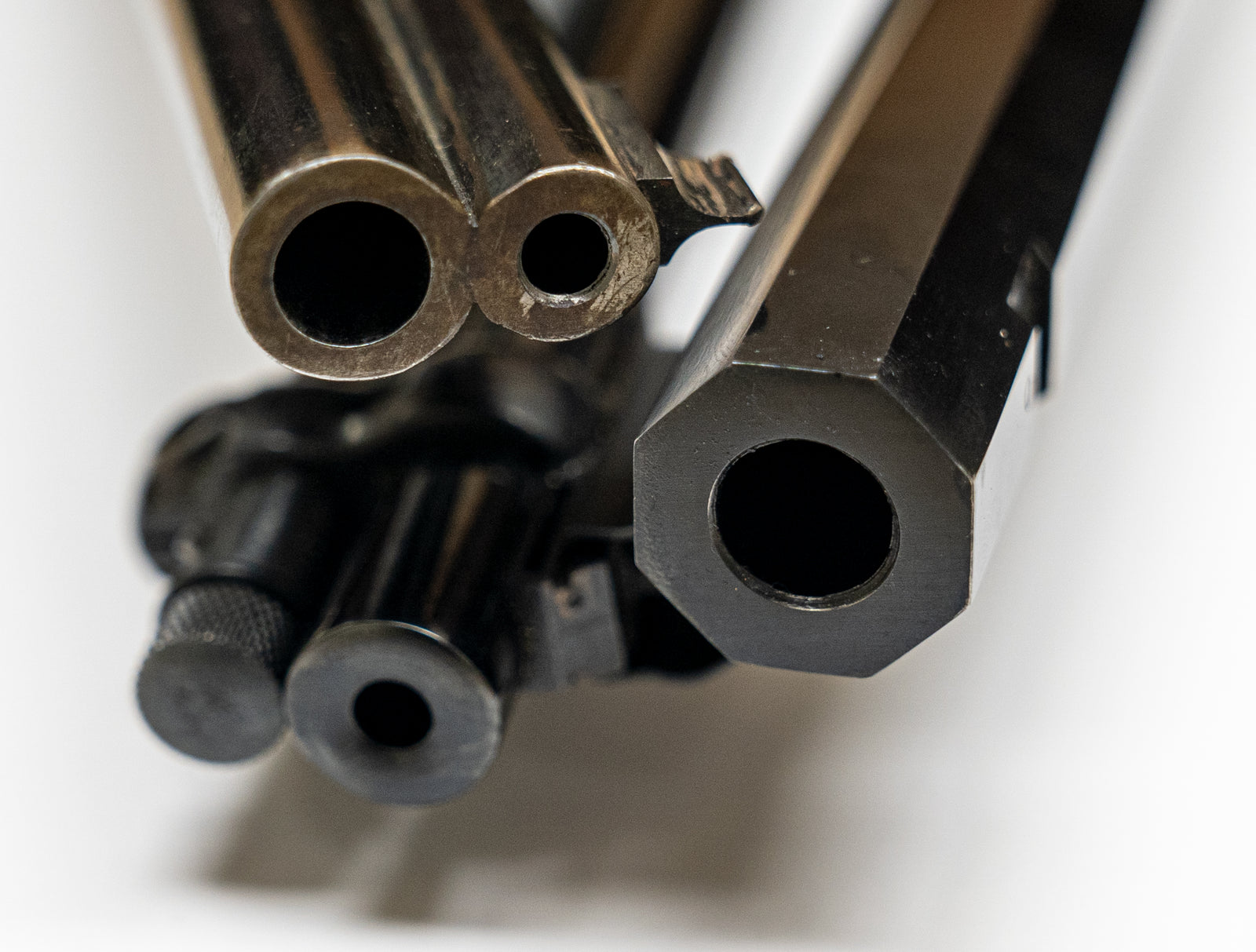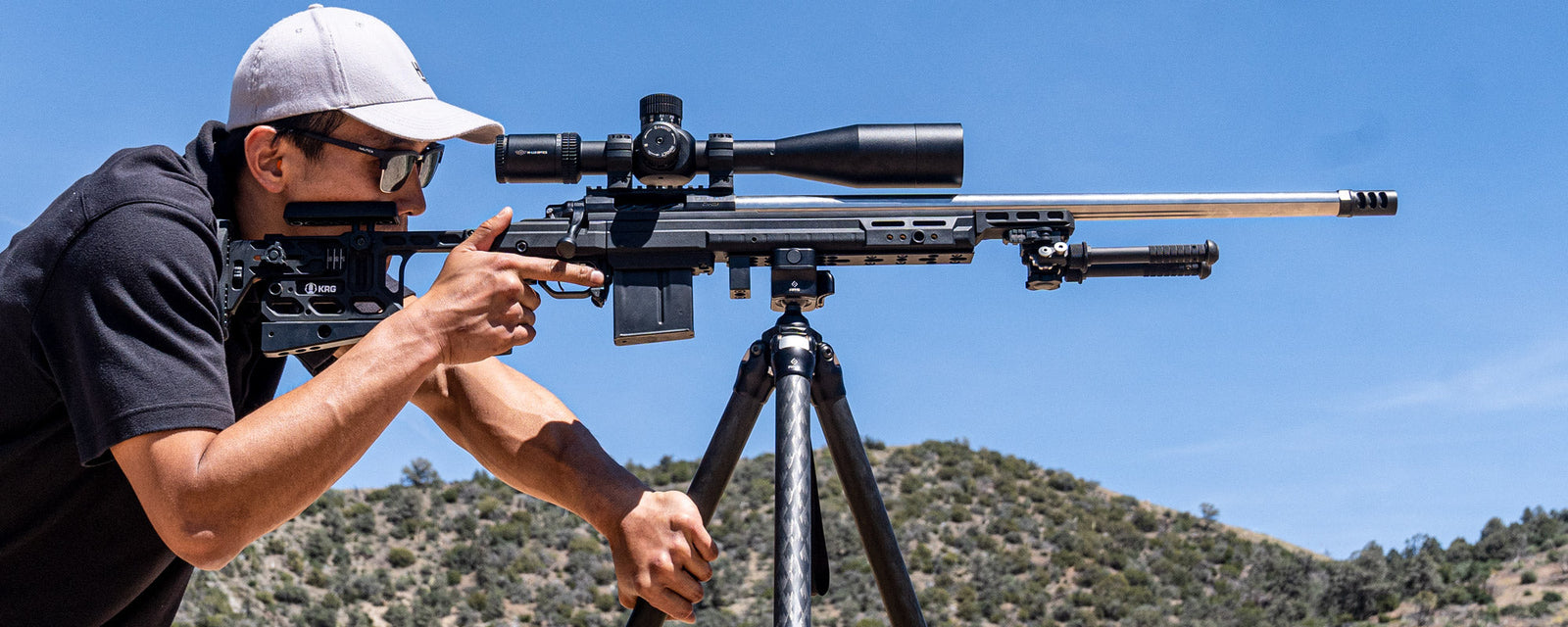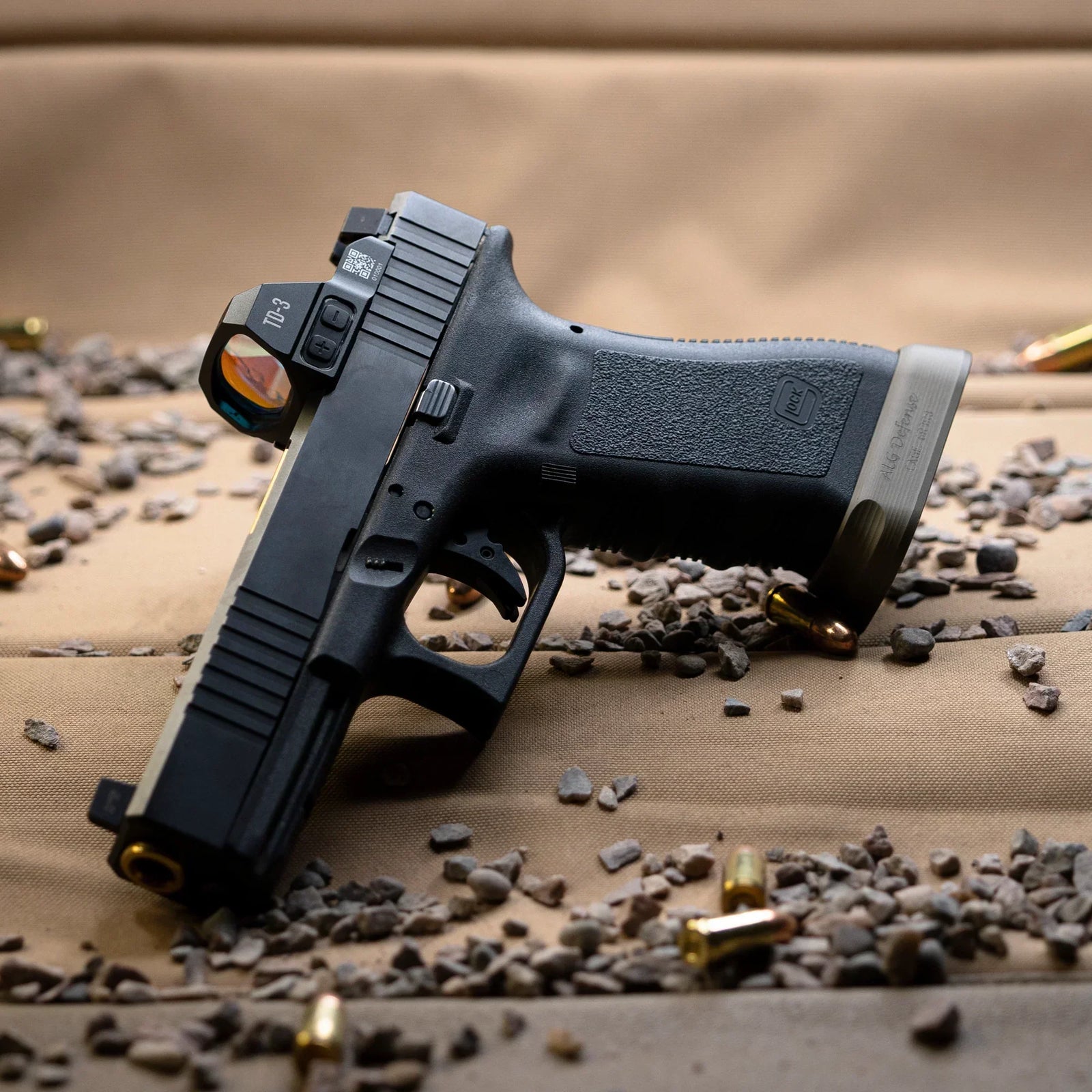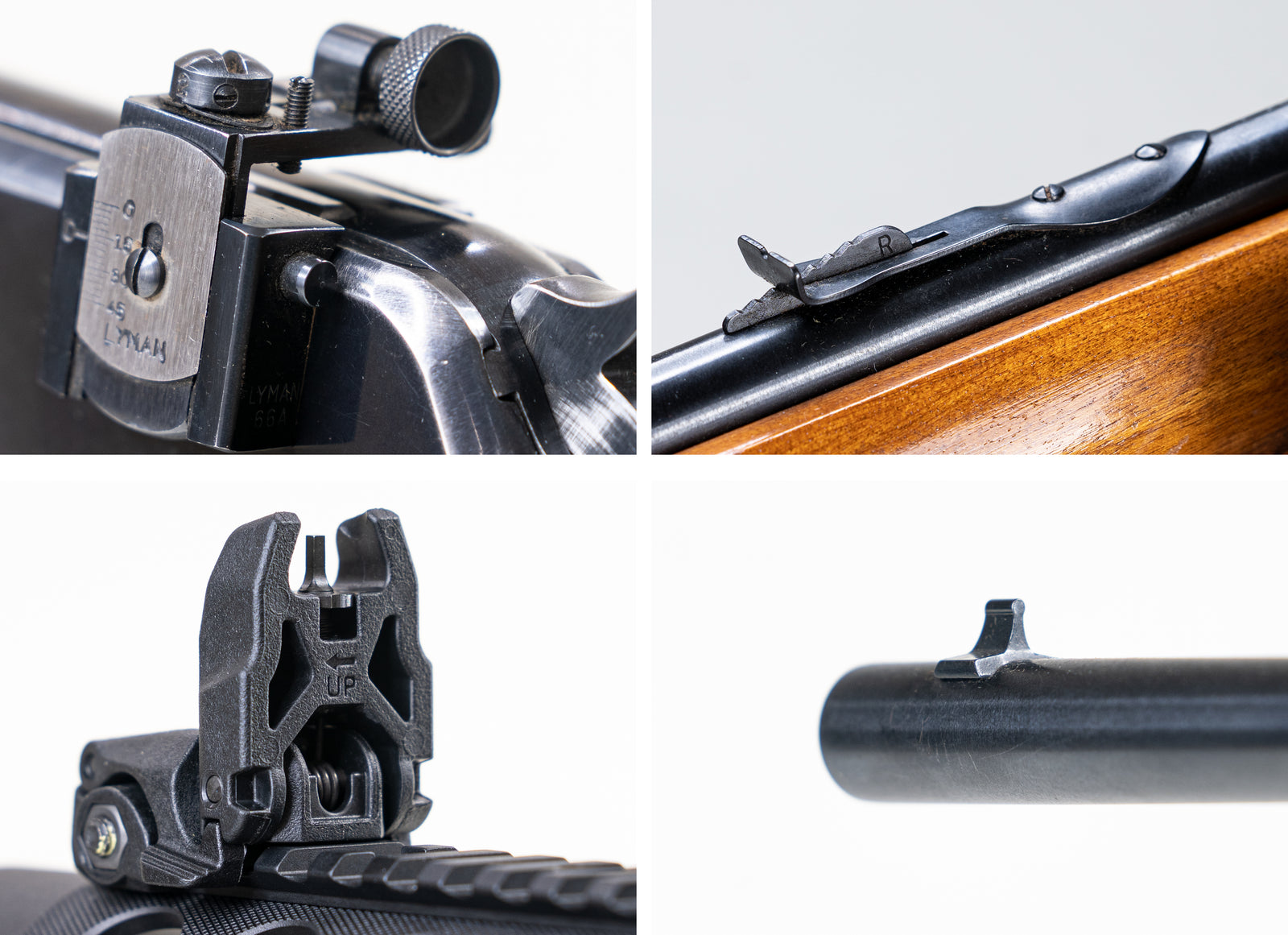
A barrel marked with the appropriate cartridge - in this case, either the .22 Short, .22 Long, or .22 Long Rifle.
The barrel is the place where the bullet builds up speed, starts to spin, and gets going on the right path. Once the primer is struck, the powder burns and heats, the reaction speeding up as more powder heats up yet more powder and sets it off too. This expanding mass of hot air and burning propellant shoves the bullet down the barrel, burning more as it goes. Then, the bullet exits the barrel. The excess pressure burps out the muzzle.
The end of the barrel that attaches to the action or receiver is called the breech end. The end of the barrel that faces away from you is the muzzle. Running through the length of the barrel is the bore - the tunnel through the middle that the bullet moves down. Back at the breech end sits the chamber, where the cartridge is held. Most modern firearms are loaded from the breech end, and can be called “breech loaders.” Older styles of rifles, known as muzzleloaders, are loaded from the muzzle end. If your rifle takes cartridges, it is a breech loader.
While the bore determines the diameter (caliber) of the bullet that the rifle can fire, the chamber determines what size and shape of cartridge the rifle can fit. The chamber is typically wider than the bore (just as many bottlenecked cases are wider than the bullet they hold), and leads into the bore with a taper. This taper is known as the lead. The metal ‘lead’ is used far more regularly in firearm-talk. For this reason, this taper is often instead spelled “leed”, to avoid confusion. If there is a smooth section of barrel between the chamber and the start of the rifling, this segment is known as the freebore.

The barrel of a rifle is a remarkably straightforward piece of metal.
The word rifle comes from the rifling running down the length of the bore. Rifling is the term for the long curving grooves inside a rifle barrel. The rifling is responsible for giving the bullet a bit of a spin as it accelerates down the length of the barrel. The spin helps gyroscopically stabilize the bullet while it's flying through the air. Way back in the days of muskets, long arms didn’t have rifling. Long arms without rifling in the barrel were called smoothbores.
In between each groove are the lands. If the grooves are valleys, the lands are the mountain tops. Interestingly, caliber is measured between the lands (the narrowest part of the bore) and not the grooves (the widest part of the bore) for cartridges designed outside of the United States. For most cartridges designed in the U.S., caliber is measured between the grooves, instead of the lands.
This is readily apparent in comparisons between the 7.62x51mm round and the .308 Winchester. The bullet used in both cartridges is the same diameter, even though 7.62mm is not .308”. The 7.62mm caliber of bullet refers to the lands dimension, which sits at a diameter of .300” in the barrel. The grooves actually reach out to .308” (7.82mm) in diameter. The bullet is similarly .308” in diameter.
The lands and grooves can vary in quantity, rate of twist, depth, and shape. Each little variation may have its own effect, though there are general guidelines that make certain shapes of grooves and rates of twist more effective at particular functions.

A look down the bore of a rifle, showing off the spiraling rifling.
One strangely important component of the barrel is the crown. This is the very front end of the rifle barrel; the actual face of the long cylinder that is the barrel. This runs from the bore outward to the outer edge of the barrel. While the crown may seem like a minor concern, it can become a major concern if the rifle is mishandled or if the crown is damaged in some way.
When the bullet finally exits the bore, the last little edge it passes along is the edge of the crown. If there is any burr on the crown (especially on the edge of the bore) that impacts the bullet’s flight, there will be no additional grooves or back pressure to help stabilize the bullet. Please do not stick the end of your barrel into or onto the dirt for any reason, as it may dent the edge where the crown and bore meet. This edge needs to be clean and sharp to allow the bullet to exit the barrel cleanly and without any impingement on its stable path.
The edge where the crown and bore meet needs to be at a perfect right angle to the bullet’s flight path. If this edge is at a slight angle, gas will escape around the bullet unevenly as it finally squeezes free of the rifling. As I’m sure you can guess, this will blow the bullet a bit off course in a potentially unpredictable way.
There are quite a few styles of crowns, most of which involve different angles of countersink or chamfer on the face to keep the bore safely recessed. The outer portion of the crown or barrel is left long, while the end of the bore is recessed by an 11 or 45 degree taper, if it doesn’t meet at a perfect right angle.

A mix of different crowns. At the top, some crowns that have been damaged. On the right, the recessed bore of an 1885 High Wall, free from any damage. Below, a rounded crown with minor markings.
The barrel’s length will determine how much time the powder has to burn. Its length is measured from the end of the bore (or tip of the crown) all the way back to where the chamber meets the breech face.
To maximize the potential velocity of your round, the barrel should be the right length for all of the powder to burn, finishing its reaction just as the bullet exits the muzzle.
If the barrel is too long, the powder will finish burning before the bullet exits the muzzle. The last segment of the bullet’s journey down the barrel will give the bullet time to slow without the constant building of pressure behind it.
Shorter barrels or rounds with too much powder will not make use of all the available powder. The velocity (and potential kinetic energy) of the round will be reduced from its maximum potential. All the excess powder will exit the barrel after the bullet, potentially igniting upon hitting the open air. No matter what, it’s going to cause a smoky mess.
Rifles can certainly still function when the barrel is a little longer or shorter than necessary for the round. Most commonly, barrels are shortened to make handling the rifle easier, or to reduce weight. The change in velocity simply needs to be accounted for in any ballistic calculations, which is usually as easy as using an online calculator.
Be aware that the length of the barrel is a point under legal contention. Shortening the barrel past certain legal limits may require additional paperwork and fees, if it is legal at all.
The below table shows common barrel lengths and velocities for a .308 Winchester cartridge. Please note, these velocities may not match your own individual setup - there’s plenty of variables to consider!
|
Barrel Length |
26” |
24” |
22” |
20” |
18” |
|
Muzzle Velocity (fps) |
2675 |
2635 |
2600 |
2565 |
2525 |
An accurate barrel depends largely on its uniformity. As long as the bore dimensions are consistent from entry to exit, the bullet will start off its long journey in a repeatable (and thus predictable) manner. If the diameter of the bore varies, it’ll squeeze down on the bullet or let gas spurt past it as each change in diameter is reached by the bullet.
Your rifle will be built with tolerances. There is a chance that your barrel may be tenths of a thousandth or more off in some dimension or other. Ammunition, especially produced commercially, will likewise have tolerances that can vary from the expected dimensions of the cartridge. Any minor variations in your bore or chamber dimensions can be compensated for by testing different cartridges. Certain cartridges will simply work with your rifle in a more precise manner, due to the matching of your tolerances and theirs.
Additionally, once you get into handloading, you’ll be able to adjust the various dimensions of the case and quantity of the powder inside it. At that point, you can hone in on the most precise load combinations for your rifle.
On many rifles, the barrel can be changed out for a new barrel. This is usually done to either fit a different caliber or cartridge, change to a different barrel length, or simply to replace a barrel that’s been worn out from too much shooting. The difficulty of changing a barrel will depend on the particular model of rifle you’re using.
Not all barrels are made equally… and not all firearms have just one barrel! You may have heard of a double-barrel shotgun, which is exactly what it sounds like. Two barrels, either side-by-side or stacked vertically. Rifles will almost always have a single barrel, but I can't deny that some multi-barrel multi-caliber rifles exist and look quite fancy.

In this very old ‘take-down’ rifle, the barrel is quite easy to remove. In other models, it may be quite a bit more difficult.





Leave a comment (all fields required)